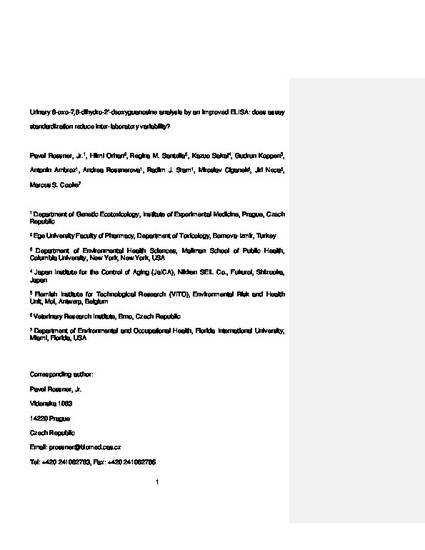
ELISA is commonly used for the detection of urinary 8-oxo-7,8-dihydro-2'-deoxyguanosine (8-oxodG), a marker of whole body oxidative stress. However, the method has been criticized for high inter-laboratory variability and poor agreement with chromatographic techniques. We performed an inter-laboratory comparison of 8-oxodG assessed in 30 urine samples and a urine spiked with four different concentrations of 8-oxodG by ELISA using standardized experimental conditions, including: sample pre-treatment with solid-phase extraction (SPE), performing analysis using a commercial kit from a single manufacturer and strict temperature control during the assay. We further compared the ELISA results with high-performance liquid chromatography-tandem mass spectrometry (HPLC-MS/MS) and performed tentative identification of compounds that may contribute to the discrepancy between both methods. For all but one participating laboratory (Data 1) we observed consistent ELISA results lying mostly within 1SD of the mean 8-oxodG concentration. Mean 8-oxodG levels assessed by ELISA correlated with the data obtained by HPLC-MS/MS (R=0.679, p<0.001). The correlation improved when Data 1 were excluded from the analysis (R=0.749, p<0.001). We identified three outlying urine samples; one with an ELISA 8-oxodG concentration lower, and two with 8-oxodG levels higher, than those measured by HPLC-MS/MS. Omitting these samples further improved inter-methodology agreement (R=0.869, p<0.001). In the outliers with high 8-oxodG estimates various aromatic and heterocyclic compounds were tentatively identified using gas chromatography-mass spectrometry (GC-MS). Application of authentic standards revealed the presence of saccharides, including d-glucose and d-galactose as putative interfering substances. In summary, assay standardization improved ELISA inter-laboratory agreement, although some variability is still observed. There are still compounds contributing to overestimation of 8-oxodG by ELISA, but only in some urine samples. Thus, despite significant improvement, ELISA still should not be considered a robust alternative to chromatographic techniques.
Available at: http://works.bepress.com/marcus-cooke/2/

Post Print Version.
Originally published in Free Radical Biology and Medicine.